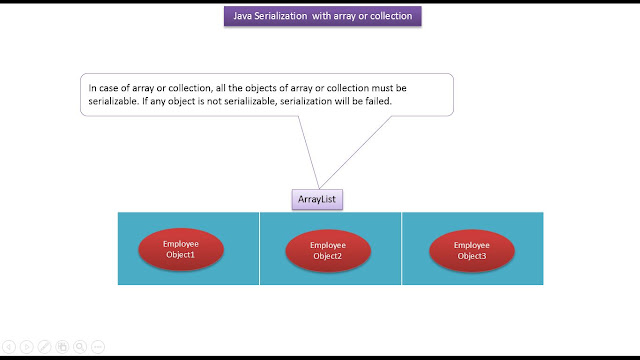Click here to watch in Youtube :
Click the below Image to Enlarge
 |
| Java Tutorial : Java IO (Java Serialization with array or collection) |
import java.io.Serializable;
public class Employee implements Serializable
{
private static final long serialVersionUID = 765764534241652904L;
private int id;
private String name;
public Employee(int id, String name)
{
super();
this.id = id;
this.name = name;
}
public int getId()
{
return id;
}
public void setId(int id)
{
this.id = id;
}
public String getName()
{
return name;
}
public void setName(String name)
{
this.name = name;
}
}
import java.io.FileNotFoundException;
import java.io.FileOutputStream;
import java.io.IOException;
import java.io.ObjectOutputStream;
import java.util.ArrayList;
public class SerializationDemo
{
public static void main(String[] args) throws FileNotFoundException,
IOException, ClassNotFoundException
{
SerializationDemo serializationDemo = new SerializationDemo();
serializationDemo.writeEmployeeObject();
}
private void writeEmployeeObject() throws FileNotFoundException,
IOException
{
FileOutputStream fileOutputStream = null;
ObjectOutputStream objectOutputStream = null;
try
{
fileOutputStream = new FileOutputStream("employee.tmp");
objectOutputStream = new ObjectOutputStream(fileOutputStream);
Employee employee1 = new Employee(101, "Peter");
Employee employee2 = new Employee(102, "Dave");
Employee employee3 = new Employee(103, "Ram");
ArrayList<Employee> listOfEmployees = new ArrayList<Employee>();
listOfEmployees.add(employee1);
listOfEmployees.add(employee2);
listOfEmployees.add(employee3);
/*
* Write the specified object to the
* ObjectOutputStream.
*/
objectOutputStream.writeObject(listOfEmployees);
System.out
.println("Successfully written list of employee objects to the file.\n");
}
finally
{
if (objectOutputStream != null)
{
/*
* Closing a ObjectOutputStream will also
* close the OutputStream instance to which
* the ObjectOutputStream is writing.
*/
objectOutputStream.close();
}
}
}
}
Successfully written list of employee objects to the file.
employee.tmp
DeSerializationDemo.java
import java.io.FileInputStream;
import java.io.FileNotFoundException;
import java.io.IOException;
import java.io.ObjectInputStream;
import java.util.ArrayList;
public class DeSerializationDemo
{
public static void main(String[] args) throws FileNotFoundException,
IOException, ClassNotFoundException
{
DeSerializationDemo deSerializationDemo = new DeSerializationDemo();
deSerializationDemo.readEmployeeObject();
}
private void readEmployeeObject() throws IOException,
FileNotFoundException, ClassNotFoundException
{
FileInputStream fileInputStream = null;
ObjectInputStream objectInputStream = null;
try
{
fileInputStream = new FileInputStream("employee.tmp");
objectInputStream = new ObjectInputStream(fileInputStream);
/*
* Read an object from the ObjectInputStream.
*/
ArrayList<Employee> listOfEmployees = (ArrayList<Employee>) objectInputStream
.readObject();
System.out
.println("Successfully read list of employee objects from the file.\n");
for (Employee employee : listOfEmployees)
{
System.out.println("Id = " + employee.getId());
System.out.println("Name = " + employee.getName());
System.out.println("--------------------------");
}
}
finally
{
if (objectInputStream != null)
{
/*
* Closing a ObjectInputStream will also
* close the InputStream instance from which
* the ObjectInputStream is reading.
*/
objectInputStream.close();
}
}
}
}
Successfully read list of employee objects from the file.
Id = 101
Name = Peter
--------------------------
Id = 102
Name = Dave
--------------------------
Id = 103
Name = Ram
--------------------------


No comments:
Post a Comment